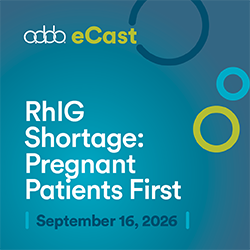

Product Code: 26EL-672-4035
Please note: This is a Single Viewer registration for one participant for the on-demand version of this program. Access instructions for the on-demand version of this program will be provided via email approximately 3-10 business days after the live program has occurred and the on-demand version is available. If registering after the on-demand version is available, immediate access is granted via the AABB Education Platform at https://education.aabb.org.
If you registered for the live program you do not need to register for this on-demand eCast (access to the on-demand eCast was included with the live program registration).
If you are interested in presenting this program to a group, please see the “eCast Registration Form– Group Viewing” form on the program page.
Program Description: Rh immune globulin (RhIG) was introduced to market in 1968 as a method of preventing anti-D alloimmunization in RhD negative pregnant women. The use of postpartum RhIG, and the later introduction of antepartum dosing, resulted in a reduction in the rate of anti-D alloimmunization in at-risk pregnancies from 13-16% to 0.14-0.2%. RhIG is one of the most important advances in perinatal medicine; however, as RhIG is a human-derived product, it is subject to the same inventory shortages that plague blood products. The FDA announced a shortage of Rh immune globulin in December 2023 that has lasted through 2025.
In late 2024, members of the Clinical Hemotherapy Subsection of the AABB Transfusion Medicine Subsection Coordinating Committee sent out a survey on RhIG usage during the shortage to AABB member institutions to assess practices. Results indicated that, even during the national shortage while there were reports of RhD negative pregnant women in scattered areas of the US being unable to receive their standard RhIG antepartum and postpartum doses, there was misuse of RhIG in populations of nonchildbearing patients. This program will discuss evidence-based use of RhIG in the target population for which it was created (RhD negative pregnant women). Non-recommended use in men and women outside of childbearing potential will be discussed and the ethics of such use will be briefly touched on.